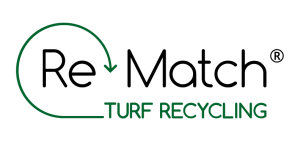Turf Tips
What to look for when replacing turf?
We have collected the best sustainable practices, which may also save existing and future pitch-owners a small fortune and a jail sentence. Get your second advice here and stay tuned next week for more sustainable practices.

You have decided to replace your old turf system – what to look out for:
- Direct re-use of your own infill. Direct re-use of your old, untreated infill may negatively affect the playability of your new pitch. It is a likely health hazard to the players, and the drainage system of your new pitch may quickly clog because of the many small rub-off particles, which have agglomerated over the years in the old infill.
Re-Match recommendations:- Use only clean, sorted infill, which can be applied in a layer-by-layer muster for your new pitches.
- Make sure that your quality requirement also for infill is clearly stated in the contract with your system provider.
- Make physical check-ups during the installation to verify, that the ordered materials are actually used for the new pitches.
- Re-use of your entire old turf system. Legally, in most countries, you could sell or give away your turf system for direct re-use. However, the new pitch-owner may inherit all the problems, which prompted you to make the replacement decision. Furthermore, the high costs for field preparation is at the same level whether the pitches are new or worn.
Re-Match recommendation:- We encourage original turf system owners to make a sustainable decision and dispose of used pitches as waste and not to leave the waste problem with a new owner, who may also face high maintenance costs during the lifetime of a used, troublesome turf system.
- Re-use of your old turf system in pieces for decorational purposes. The demand for old turf for decorational purposes is rather limited. After decorational use, nobody seems to take responsibility for proper disposal of old turf. Thus, turf pitches bound for decoration often end up in nature or incineration plants potentially creating a lot of harm to the environment.
Re-Match recommendation:- We trust that pitch-owners would like to act responsibly. In order to ensure that your old pitch will get out of harm’s way, we encourage that old turf systems should not be used for other purposes, but be handled by professionals as waste.
- Thermal incineration. The incineration of artificial turf pitches will generate much CO2. A specific research study documented an emission of approximately 337 tons of CO2 as the result of the incineration of a standard size turf pitch with a size of 7000 m2 and weighing in at 288 tons. When you incinerate a turf system then you will need to produce new raw materials in order to be able to construct a new pitch. Another study have produced evidence that the production of 82 tons of new raw materials (polyethylene and polypropylene) will cause the emission of another 82 tons of CO2. The total environmental impact is close to 419 tons CO2.
Re-Match recommendation:- From a sustainable perspective, incineration is not a valid option. As a pitch-owner, you need to consider whether such an impact is acceptable for your company or organization. We encourage pitch-owners to support the politics of the circular economy and opt for a recycling solution.
- Waste deposit: Please note that the EU Waste Directive forbids the disposal of shredded tires at waste deposits. Shredded tires (or SBR) is a basic component of many artificial turf systems – and it is almost impossible to separate more than approx. 70-80 percent of the infill from the used carpet.
Re-Match recommendation: -
- Due to the content of infill, it is not legal to send a used carpet for incineration. We encourage pitch-owners to choose recycling as their preferred method of disposal.
CONTACT
T: +45 77 34 67 34
E: info@re-match.com
ADDRESS
Re-Match A/S
HI-Park 415
7400 Herning
Denmark



